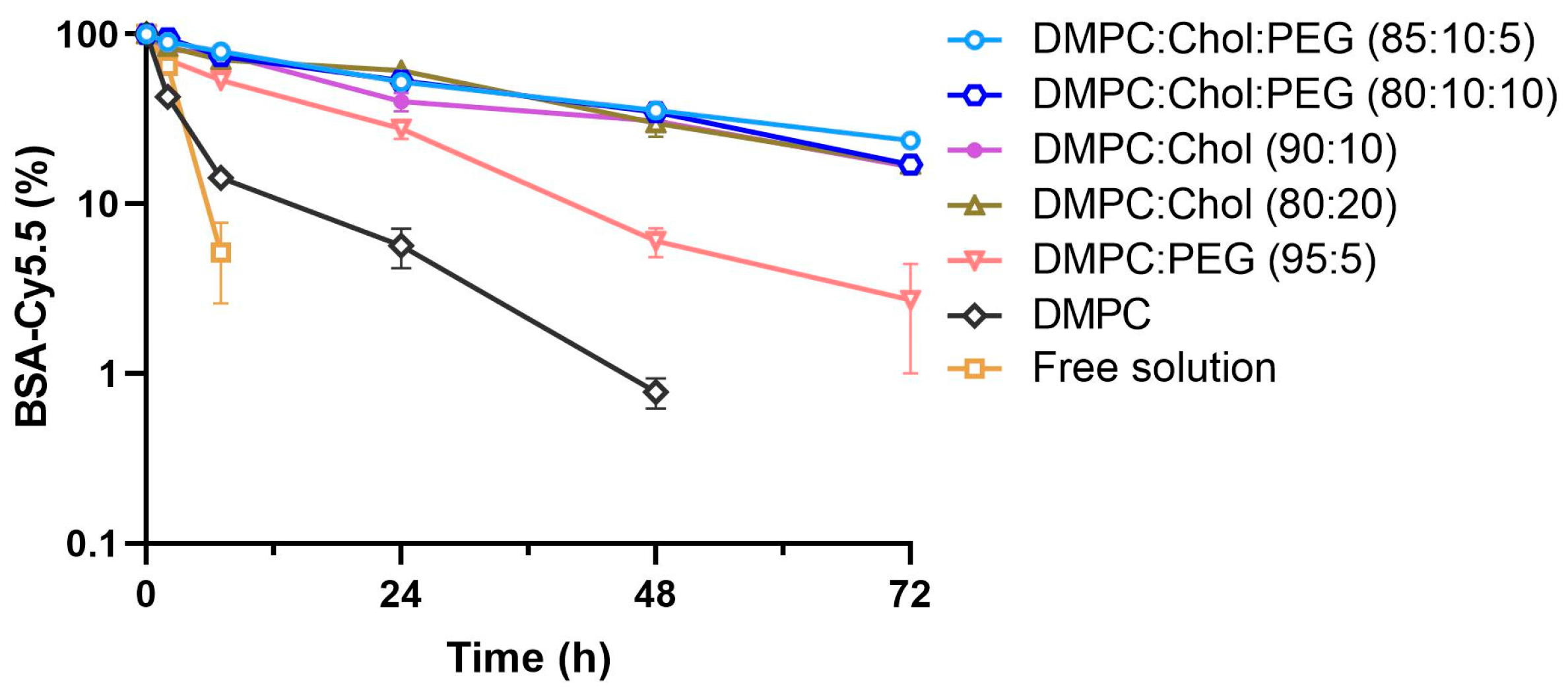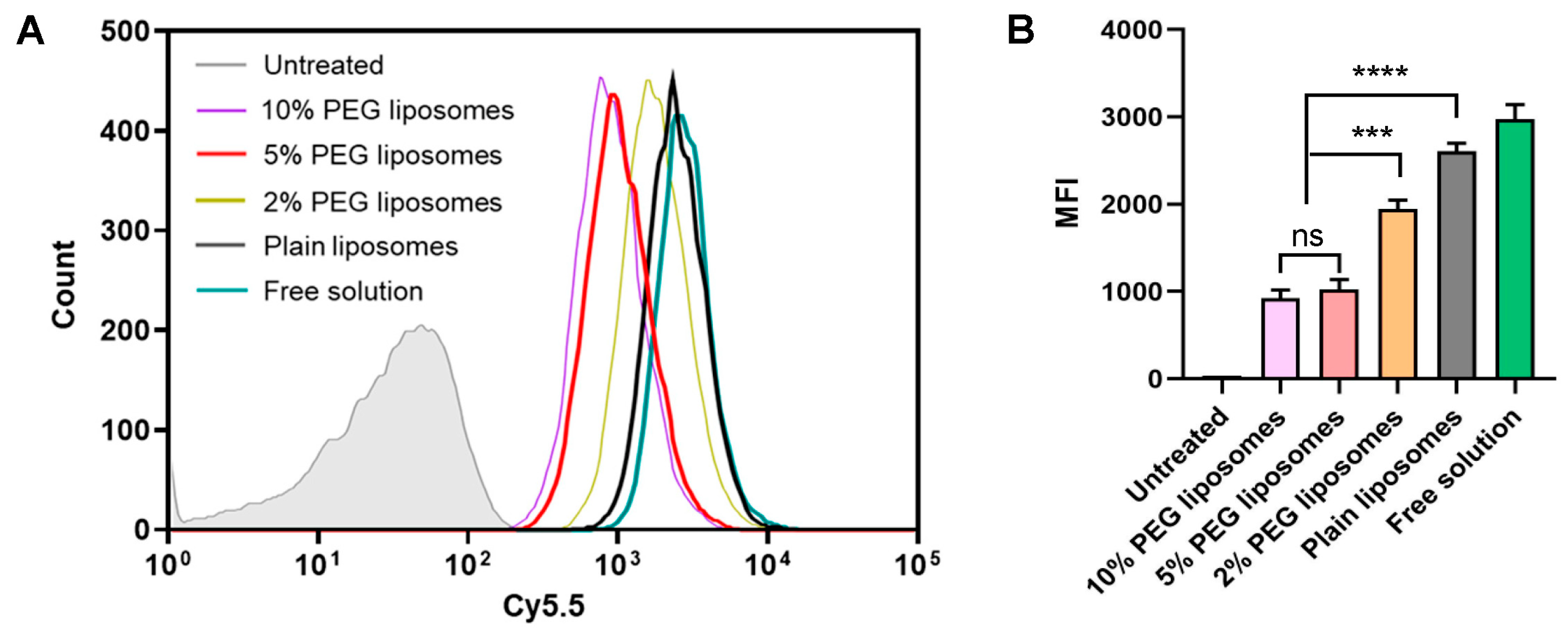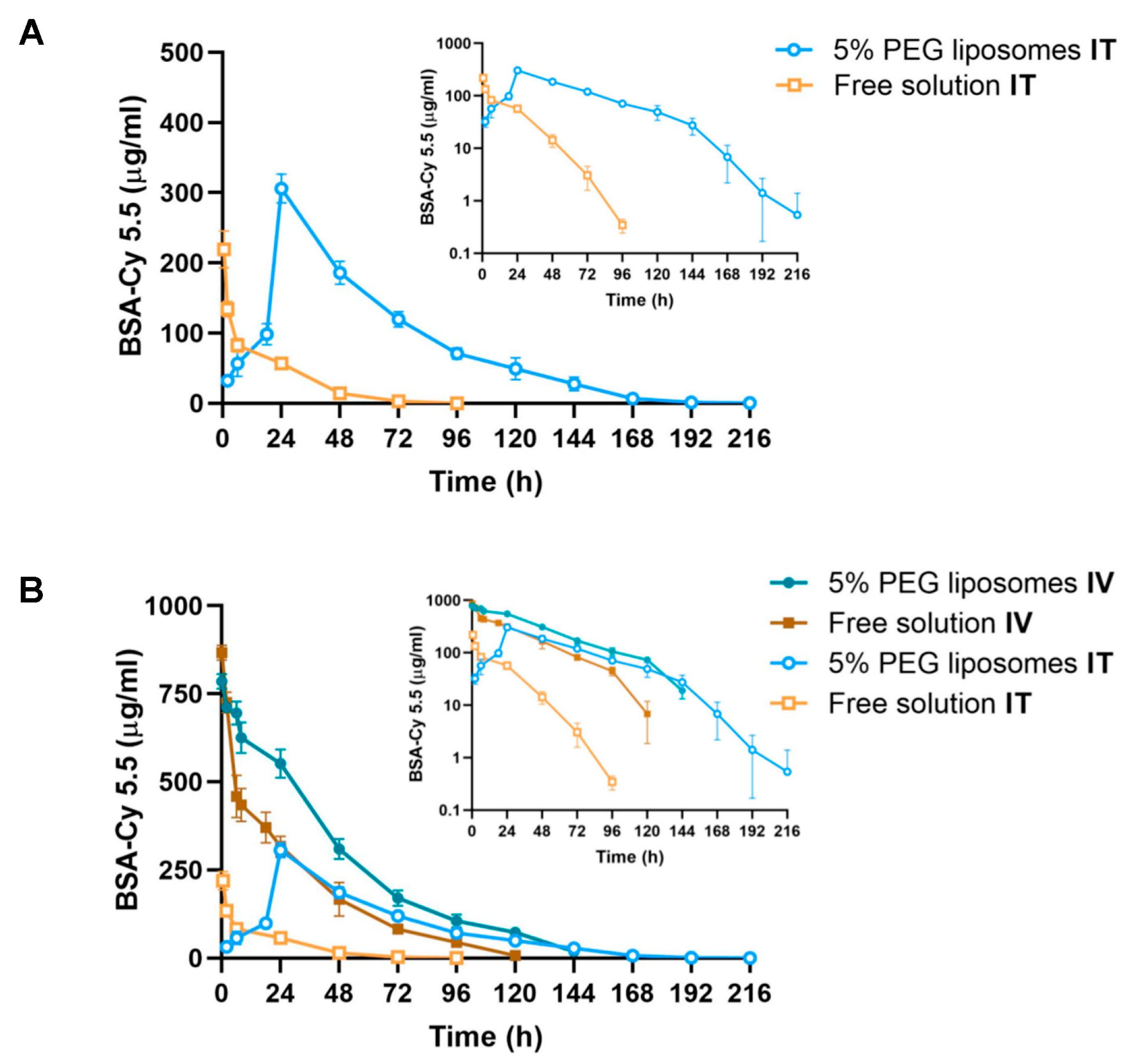Systemic Protein Delivery via Inhalable Liposomes: Formulation and Pharmacokinetics
Abstract
1. Introduction
2. Materials and Methods
2.1. Chemicals
2.2. Cell Culture
2.3. Conjugation of BSA-Cy5.5
2.4. Preparation and Characterization of BSA-Cy.5.5-Encapsulated Liposomes
2.5. In Vitro Release Study
2.6. Macrophage Uptake of BSA-Cy5.5-Loaded Liposomes
2.7. Pharmacokinetics of Liposomal Versus Free BSA-Cy5.5
2.8. Whole-Body NIR Fluorescence Imaging
2.9. Statistical Analysis
3. Results
3.1. Sythesis and Characterization of BSA-Cy5.5-Loaded Liposomes
3.2. Factors Influencing the Release Kinetics of BSA-Cy5.5 from DMPC-Based Liposomes
3.3. PEG Modification of Liposomes Attenuates the Macrophage Uptake of Liposomal BSA-Cy5.5
3.4. Inhaled DMPC-Based Liposomes Increase the Systemic Absorption of BSA-Cy5.5 in Mice
4. Discussion
5. Conclusions
Author Contributions
Funding
Institutional Review Board Statement
Informed Consent Statement
Data Availability Statement
Acknowledgments
Conflicts of Interest
References
- Berlinski, A. 2019 Year in review: Aerosol therapy. Respir. Care 2020, 65, 705–712. [Google Scholar] [CrossRef] [PubMed]
- Newman, S.P. Drug delivery to the lungs: Challenges and opportunities. Ther. Deliv. 2017, 8, 647–661. [Google Scholar] [CrossRef] [PubMed]
- Ho, D.K.; Nichols, B.L.; Edgar, K.J.; Murgia, X.; Loretz, B.; Lehr, C.M. Challenges and strategies in drug delivery systems for treatment of pulmonary infections. Eur. J. Pharm. Biopharm. 2019, 144, 110–124. [Google Scholar] [CrossRef] [PubMed]
- Kumar, R.; Mehta, P.; Shankar, K.R.; Rajora, M.A.; Mishra, Y.K.; Mostafavi, E.; Kaushik, A. Nanotechnology-assisted metered-dose inhalers (MDIs) for high-performance pulmonary drug delivery applications. Pharm. Res. 2022, 39, 2831–2855. [Google Scholar] [CrossRef]
- Patton, J.S.; Byron, P.R. Inhaling medicines: Delivering drugs to the body through the lungs. Nat. Rev. Drug Discov. 2007, 6, 67–74. [Google Scholar] [CrossRef]
- Yu, J.; Chien, Y.W. Pulmonary drug delivery: Physiologic and mechanistic aspects. Crit. Rev. Ther. Drug Carrier Syst. 1997, 14, 395–453. [Google Scholar] [CrossRef] [PubMed]
- Czechtizky, W.; Su, W.; Ripa, L.; Schiesser, S.; Höijer, A.; Cox, R.J. Advances in the design of new types of inhaled medicines. Prog. Med. Chem. 2022, 61, 93–162. [Google Scholar]
- Muttenthaler, M.; King, G.F.; Adams, D.J.; Alewood, P.F. Trends in peptide drug discovery. Nat. Rev. Drug Discov. 2021, 20, 309–325. [Google Scholar] [CrossRef]
- Leader, B.; Baca, Q.J.; Golan, D.E. Protein therapeutics: A summary and pharmacological classification. Nat. Rev. Drug Discov. 2008, 7, 21–39. [Google Scholar] [CrossRef]
- Patton, J.S.; Fishburn, C.S.; Weers, J.G. The lungs as a portal of entry for systemic drug delivery. Proc. Am. Thorac. Soc. 2004, 1, 338–344. [Google Scholar] [CrossRef]
- Liang, W.; Pan, H.W.; Vllasaliu, D.; Lam, J.K. Pulmonary delivery of biological drugs. Pharmaceutics 2020, 12, 1025. [Google Scholar] [CrossRef] [PubMed]
- Siekmeier, R.; Scheuch, G. Systemic treatment by inhalation of macromolecules–principles, problems, and examples. J. Physiol. Pharmacol. 2008, 59, 53–79. [Google Scholar]
- Lombry, C.; Edwards, D.A.; Préat, V.; Vanbever, R. Alveolar macrophages are a primary barrier to pulmonary absorption of macromolecules. Am. J. Physiol. Lung Cell Mol. Physiol. 2004, 286, L1002–L1008. [Google Scholar] [CrossRef] [PubMed]
- Stein, S.W.; Thiel, C.G. The history of therapeutic aerosols: A chronological review. J. Aerosol Med. Pulm. Drug Deliv. 2017, 30, 20–41. [Google Scholar] [CrossRef] [PubMed]
- Large, D.E.; Abdelmessih, R.G.; Fink, E.A.; Auguste, D.T. Liposome composition in drug delivery design, synthesis, characterization, and clinical application. Adv. Drug Deliv. Rev. 2021, 176, 113851. [Google Scholar] [CrossRef]
- Ponkshe, P.; Feng, S.; Tan, C. Inhalable liposomes for treating lung diseases: Clinical development and challenges. Biomed. Mater. 2021, 16, 054101. [Google Scholar] [CrossRef]
- Marques, M.R.; Loebenberg, R.; Almukainzi, M. Simulated biological fluids with possible application in dissolution testing. Dissolution Technol. 2011, 18, 15–28. [Google Scholar] [CrossRef]
- Sheikholeslami, B.; Lam, N.W.; Dua, K.; Haghi, M. Exploring the impact of physicochemical properties of liposomal formulations on their in vivo fate. Life Sci. 2022, 300, 120574. [Google Scholar] [CrossRef]
- Wauthoz, N.; Amighi, K. Phospholipids in pulmonary drug delivery. Eur. J. Lipid Sci. Technol. 2014, 116, 1114–1128. [Google Scholar] [CrossRef]
- Liu, F.Y.; Shao, Z.; Kildsig, D.O.; Mitra, A.K. Pulmonary delivery of free and liposomal insulin. Pharm. Res. 1993, 10, 228–232. [Google Scholar] [CrossRef]
- Jurima-Romet, M.; Shek, P.N. Lung uptake of liposome-entrapped glutathione after intratracheal administration. J. Pharm. Pharmacol. 1991, 43, 6–10. [Google Scholar] [CrossRef] [PubMed]
- Allen, T.M.; Cullis, P.R. 2013. Liposomal drug delivery systems: From concept to clinical applications. Adv. Drug Deliv. Rev. 2013, 65, 36–48. [Google Scholar] [CrossRef] [PubMed]
- Briuglia, M.L.; Rotella, C.; McFarlane, A.; Lamprou, D.A. Influence of cholesterol on liposome stability and on in vitro drug release. Drug Deliv. Transl. Res. 2015, 5, 231–242. [Google Scholar] [CrossRef] [PubMed]
- Chono, S.; Tanino, T.; Seki, T.; Morimoto, K. Uptake characteristics of liposomes by rat alveolar macrophages: Influence of particle size and surface mannose modification. J. Pharm. Pharmacol. 2007, 59, 75–80. [Google Scholar] [CrossRef]
- Suk, J.S.; Xu, Q.; Kim, N.; Hanes, J.; Ensign, L.M. PEGylation as a strategy for improving nanoparticle-based drug and gene delivery. Adv. Drug Deliv. Rev. 2016, 99, 28–51. [Google Scholar] [CrossRef]
- Mcleod, V.M.; Chan, L.J.; Ryan, G.M.; Porter, C.J.; Kaminskas, L.M. Optimal PEGylation can improve the exposure of interferon in the lungs following pulmonary administration. J. Pharm. Sci. 2015, 104, 1421–1430. [Google Scholar] [CrossRef]
- Koussoroplis, S.J.; Paulissen, G.; Tyteca, D.; Goldansaz, H.; Todoroff, J.; Barilly, C.; Uyttenhove, C.; Van Snick, J.; Cataldo, D.; Vanbever, R. PEGylation of antibody fragments greatly increases their local residence time following delivery to the respiratory tract. J. Control. Release 2014, 187, 91–100. [Google Scholar] [CrossRef]
- John, T.A.; Vogel, S.M.; Minshall, R.D.; Ridge, K.; Tiruppathi, C.; Malik, A.B. Evidence for the role of alveolar epithelial gp60 in active transalveolar albumin transport in the rat lung. J. Physiol. 2001, 533, 547–559. [Google Scholar] [CrossRef]
- Hastings, R.H.; Folkesson, H.G.; Petersen, V.; Ciriales, R.; Matthay, M.A. Cellular uptake of albumin from lungs of anesthetized rabbits. Am. J. Physiol. Lung Cell Mol. Physiol. 1995, 269, L453–L462. [Google Scholar] [CrossRef]




| Compositions (Molar Ratio) | EE (%) | Particle Size (nm) | PDI | ξ Potential (mV) |
|---|---|---|---|---|
| DMPC | 52.1 ± 2.3 | 127.1 ± 3.9 | 0.23 ± 0.03 | −12.7 ± 2.1 |
| DMPC/PEG (95:5) | 50.6 ± 1.5 | 115.6 ± 2.6 | 0.29 ± 0.01 | −9.5 ± 0.7 |
| DMPC/Chol (90:10) | 69.6 ± 1.4 | 127.1 ± 5.5 | 0.28 ± 0.06 | −11.8 ± 0.3 |
| DMPC/Chol (80:20) | 67.3 ± 2.6 | 132.2 ± 2.5 | 0.24 ± 0.03 | −6.3 ± 2.7 |
| DMPC/Chol/PEG (85:10:5) | 70.4 ± 0.7 | 129.1 ± 2.8 | 0.22 ± 0.04 | −7.7 ± 0.5 |
| DMPC/Chol/PEG (80:10:10) | 71.2 ± 2.0 | 125.5 ± 0.6 | 0.33 ± 0.02 | −11.1 ± 1.5 |
| DMPC/Chol/PEG (60:30:10) | 55.7 ± 3.1 | 132.1 ± 2.7 | 0.32 ± 0.01 | −12.0 ± 1.0 |
| Compositions (Molar Ratio) | Release Rate Constant (h−1) | Release Half-Life (h) | Goodness of Fit |
|---|---|---|---|
| Free solution | 1.850 ± 0.235 | 0.4 ± 0.1 | 0.994 |
| DMPC | 0.291 ± 0.060 | 2.4 ± 0.5 | 0.972 |
| DMPC/PEG (95:5) | 0.073 ± 0.023 | 9.5 ± 3.9 | 0.977 |
| DMPC/Chol (90:10) | 0.029 ± 0.004 | 24.3 ± 4.4 | 0.969 |
| DMPC/Chol (80:20) | 0.026 ± 0.003 | 26.2 ± 2.8 | 0.991 |
| DMPC/Chol/PEG (85:10:5) | 0.028 ± 0.002 | 25.1 ± 2.3 | 0.995 |
| DMPC/Chol/PEG (80:10:10) | 0.025 ± 0.003 | 27.4 ± 2.7 | 0.990 |
| Pharmacokinetic Parameters | 5% PEG Liposomes | Free Solution | ||
|---|---|---|---|---|
| IT | IV | IT | IV | |
| Dose (mg) | 2 | 1 | 2 | 1 |
| Cmax (µg/mL) | 306 ± 21 | 785 ± 27 | 219 ± 26 | 868 ± 20 |
| tmax (h) | 24 | 0.08 | 0.5 | 0.08 |
| AUC0-last (µg/mL·h) | 16,761 ± 1333 | 37,765 ± 2915 | 2927 ± 340 | 21,299 ± 1972 |
| F (%) | 22.2 ± 1.8 | 100 ± 7.7 | 6.9± 0.8 | 100 ± 9.3 |
| MRT (h) | 58.6 ± 4.4 | 39.2 ± 1.3 | 19.3 ± 1.6 | 30.3 ± 1.1 |
Disclaimer/Publisher’s Note: The statements, opinions and data contained in all publications are solely those of the individual author(s) and contributor(s) and not of MDPI and/or the editor(s). MDPI and/or the editor(s) disclaim responsibility for any injury to people or property resulting from any ideas, methods, instructions or products referred to in the content. |
© 2023 by the authors. Licensee MDPI, Basel, Switzerland. This article is an open access article distributed under the terms and conditions of the Creative Commons Attribution (CC BY) license (https://creativecommons.org/licenses/by/4.0/).
Share and Cite
Ponkshe, P.; Wang, Y.; Tan, C. Systemic Protein Delivery via Inhalable Liposomes: Formulation and Pharmacokinetics. Pharmaceutics 2023, 15, 1951. https://doi.org/10.3390/pharmaceutics15071951
Ponkshe P, Wang Y, Tan C. Systemic Protein Delivery via Inhalable Liposomes: Formulation and Pharmacokinetics. Pharmaceutics. 2023; 15(7):1951. https://doi.org/10.3390/pharmaceutics15071951
Chicago/Turabian StylePonkshe, Pranav, Yingzhe Wang, and Chalet Tan. 2023. "Systemic Protein Delivery via Inhalable Liposomes: Formulation and Pharmacokinetics" Pharmaceutics 15, no. 7: 1951. https://doi.org/10.3390/pharmaceutics15071951
APA StylePonkshe, P., Wang, Y., & Tan, C. (2023). Systemic Protein Delivery via Inhalable Liposomes: Formulation and Pharmacokinetics. Pharmaceutics, 15(7), 1951. https://doi.org/10.3390/pharmaceutics15071951





